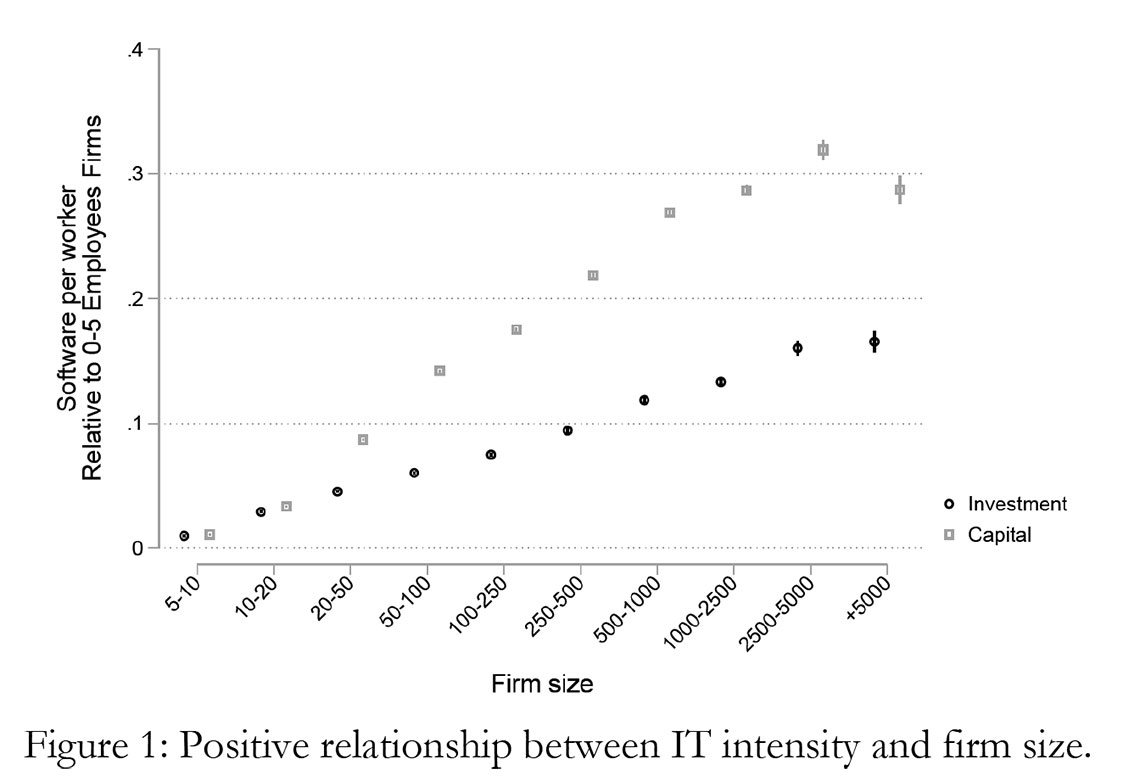
Working Paper Series no. 737: Information Technology and Returns to Scale
This paper investigates the role of IT in shaping recent trends in market concentration, factor income shares, and market competition. Relying on a novel dataset on hardware and software investments in the universe of French firms, we document a robust within-industry correlation between firm size and the intensity of IT demand. To explain this fact, we argue that the relative marginal product of IT inputs may rise with firm scale, since IT specifically helps firms deal with organizational limits to scale. We propose a general equilibrium model of industry dynamics that features firm-level production functions compatible with this mechanism. We estimate the production function and find evidence for the nonhomotheticity of IT demand and for an elasticity of substitution between IT and other inputs that falls below unity. Under the estimated model parameters, the cross-sectional predictions of the model match the observed relationship of firm size with IT intensity (positive) and labor share (negative). In addition, as a response to the fall in the relative price of IT inputs in post-1990 France, the model can explain about half of both the observed rise in market concentration and the observed market reallocation toward low-labor-share-firms.
The rise of Information Technology (IT) has drastically lowered the quality-adjusted prices of computing and information-intensive tools over the past few decades, and the resulting adoption of IT allowed firms to coordinate their activities more effectively, and to engage in more complex production processes.
The role of IT in fueling aggregate productivity growth has been so pronounced that one can explain different recent growth experiences across advanced economies based on their success in realizing the potentials of IT, but the distribution of the benefits of this IT-fueled productivity gains between workers and owners of capital (and firms) has been unequal.
In particular, we show that starting in 1990, France experienced a rise in industry levels of concentration, and that while the labor share of the typical firm has increased, the market shares of firms with high labor share decreased relative to those with low labor share. Moreover, we show that industries where concentration increased more experienced a larger decrease in their aggregate labor share.
We offer a simple framework for understanding the role of IT in shaping aggregate productivity, factor income shares and industry concentration. We distinguish IT from other types of capital and allow the marginal product of IT relative to other inputs to vary with the size of the firm. We motivate our approach by showing a strong positive correlation between the IT intensity of firms and their size, at all levels of the size distribution (see Figure 1), indicating that production becomes more IT intensive with size.
We find evidence for both an increasing role of IT in the production process when a firm’s scale of operations increases, and a strong complementarity of IT with other inputs. We rationalize these findings by the idea that a firm’s productivity is a function of two complementary dimensions: 1/ technology and 2/organizational efficiency, and that the latter decreases with firm size but increases with IT intensity. We interpret our results as evidence that IT helps mitigate the higher costs associated with scale and complexity.
Importantly, our study offers an explanation for the observed rise in concentration and the observed marker reallocation toward low-labor-share firms: when the price of IT falls, larger firms disproportionately benefit because their production process is more IT intensive to begin with. They can lower their prices and raise their market shares, which increases concentration. Moreover, because these larger firms are more complex, they have lower returns to scale, and therefore higher profit shares and lower labor shares: the rise in concentration has a negative effect on the aggregate labor share. Finally, because of the complementarity of IT with non IT inputs, a fall in the price of IT has a positive impact on the labor share, at the firm-level.
Our model shows that the rise of IT explains around half of the rise in concentration in France, and despite an apparent stability of the labor share, half of the rise of the typical firm labor share and half of the market reallocation toward low labor-share-firms.
Download the PDF version of this document

- Published on 11/07/2019
- 85 pages
- EN
- PDF (2.73 MB)
Updated on: 11/07/2019 14:23
